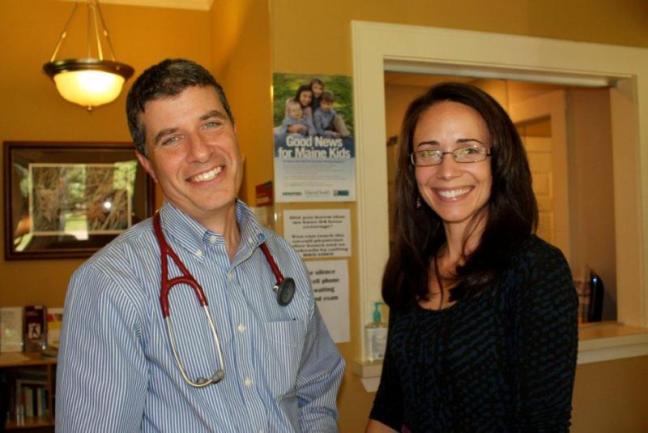By
Posted:
Tuesday, June 25, 2013 - 7:30pm
Dr. Michael and Rebecca Clark’s Lifespan Family Healthcare practice in Newcastle offers a patient-centered model of healthcare. SUE MELLO/Boothbay Register
As part of its decision to close the St. Andrews Hospital emergency room, Lincoln County Healthcare has proposed greater emphasis on primary and outpatient care.
Administrators and doctors have said they want to develop a Patient-Centered Medical Home (PCMH) model of care at the Family Care Center so that patients are healthier, better-served and actively engaged in their health and healthcare.
But what a patient-centered model looks like may still not be clear to many in the community.
On June 21, Dr. Michael Clark, one of the few private practice doctors in the region, provided members of LCH’s community advisory committee an overview of his experience with PCMH care.
In an interview last September, Clark said his desire for another approach to healthcare began when he was an employed physician in Washington, D.C.
“I was struck by a patient’s comment: ‘I love you; I hate your practice.’ And it was a good practice,” Clark said. “But there was a disconnect between what happened in the doctor’s office and outside of it.”
Closing that disconnect and developing a different culture of patient care were primary goals when Clark and his wife, Rebecca, a family and marriage therapist, opened their Lifespan Family Healthcare Center in 2005.
In 2009, Lifespan joined the Maine PCMH Pilot Program, part of a nationwide effort to assess the benefits of the model.
On Friday, Clark said the patient-centered model is designed to address some of the pitfalls of modern healthcare: a reimbursement system that rewards doing more rather than sustaining health, difficulty obtaining appointments and care when needed, fragmented and uncoordinated care, and practices that are centered around doctors’ schedules rather than patients’ needs.
How does PCMH work?
“The model isn’t that radical a concept,” Clark said. “It’s old-fashioned caring in a complex environment.”
To improve patients’ access to care, Clark said openings are intentionally left in the daily schedule to allow space for same-day visits, evening office hours are offered, and “virtual appointments” allow patients to obtain medication refills or have questions answered without an office visit.
Patients are also able to access information in their medical record, including test results, at any time through an Internet-accessed patient portal and they can use email to communicate with providers.
Essential to PCMH’s success is a team approach to care, Clark said. Each work day at Lifespan begins with a morning “huddle” to review the day’s schedule and patients’ needs. The team works to ensure that some of what might have formerly slipped through the cracks doesn’t. That process includes identifying and scheduling needed care, coordinating and tracking referrals, addressing the mental health needs of patients, and also includes a nurse care manager who regularly checks in with high-risk patients in their homes.
Although PCMH is in some ways a return to an earlier, holistic approach to healthcare, its success is reliant on modern technology. Clark characterized the transition to electronic medical records as painful for both clinicians and patients, but said the advantages far exceed the costs. Clark said electronic medical records allow for easier tracking of complex medical problems, help to prevent medication prescription errors, provide automatic reminders for overdue care, flag critical lab values and improve coordination among different specialists and healthcare facilities. Equally important, patients have the same access to all of their records as providers.
Clark said patients’ access to their electronic medical record makes the healthcare relationship more transparent and enables patients to become more active partners in their health. Shared responsibility for wellness is a key part of the PCMH model.
In the patient-centered model, the patient is not only expected to be an active participant in his or her own wellness, they are also invited to help in improving their care. Clark said Lifespan’s patients are regularly asked for feedback and a patient advisory council meets monthly to consider ways to enhance the practice.
“The advisory council has had a real influence on what we do and what we look like,” he said.
Clark said engaged and informed patients are the key to reforming healthcare. “The more I try to fix my practice, the more I believe it’s patients that will save healthcare,” he said. “Bringing patients on board, I think, is the only way we can do it.”
Clark recommends the July 2013 issue of Consumer Reports to anyone interested in more information on PCMH.
Sue Mello can be reached at 207-844-4628 or suemello@boothbayregister.com
http://www.boothbayregister.com/article/patients-center-healthcare/16588
http://www.boothbayregister.com/article/patients-center-healthcare/16588

No comments:
Post a Comment